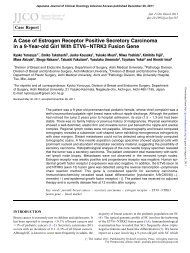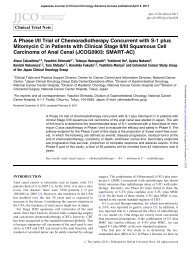Phase II Trial of Concurrent Chemoradiotherapy with S-1 Plus ...
Phase II Trial of Concurrent Chemoradiotherapy with S-1 Plus ...
Phase II Trial of Concurrent Chemoradiotherapy with S-1 Plus ...
Create successful ePaper yourself
Turn your PDF publications into a flip-book with our unique Google optimized e-Paper software.
Page 2 <strong>of</strong> 4 <strong>Phase</strong> <strong>II</strong> trial <strong>of</strong> CRT for advanced head and neck cancer<br />
PROTOCOL DIGEST OF THE JCOG0706<br />
PURPOSE<br />
The aim <strong>of</strong> this study is to evaluate the efficacy and safety <strong>of</strong><br />
concurrent CRT <strong>with</strong> S-1 plus cisplatin in patients <strong>with</strong> unresectable<br />
locally advanced SCCHN.<br />
STUDY SETTING<br />
The study is a multi-institutional <strong>Phase</strong> <strong>II</strong> study.<br />
RESOURCES<br />
The study is supported by Grants-in-Aid for Cancer<br />
Research (18-19, 20S-3, 20S-6) from the Ministry <strong>of</strong> Health,<br />
Labour and Welfare <strong>of</strong> Japan.<br />
ENDPOINTS<br />
The primary endpoint is the clinical complete remission rate,<br />
which is the proportion <strong>of</strong> complete response (CR) and good<br />
partial response (good PR) in all eligible patients. Good PR<br />
is defined as a remaining secondary change <strong>with</strong> tumor<br />
shrinkage such that the remaining tissue is not regarded as<br />
residual tumor but rather as scar material. Our evaluative<br />
guidelines suggested identifying good PR lesions as 10 mm<br />
or less in size and not enhanced on contrasted computed tomography<br />
scan. The secondary endpoints are local progressionfree<br />
survival, progression-free survival, overall survival, time<br />
to treatment failure, proportion <strong>of</strong> patients achieving nutritional<br />
support-free survival and adverse events.<br />
Local progression-free survival is the time from enrollment<br />
to local disease progression or death from any cause.<br />
Progression-free survival is defined as the time from enrollment<br />
to any disease progression or death from any cause. Overall<br />
survival is defined as days from enrollment to death from any<br />
cause. Time to treatment failure is defined as the time from<br />
enrollment to any disease progression, <strong>of</strong>f-protocol treatment<br />
or death from any cause. Proportion <strong>of</strong> nutritional support-free<br />
survival denotes the percentage <strong>of</strong> surviving patients not<br />
requiring any nutritional support at the time <strong>of</strong> treatment start<br />
and then 2, 6, 12 and 24 months after registration.<br />
ELIGIBILITY CRITERIA<br />
INCLUSION CRITERIA<br />
For inclusion in the study, the patient must fulfill all <strong>of</strong> the<br />
following criteria: (i) histologically proven squamous cell<br />
carcinoma; (ii) primary lesion located at oropharynx, hypopharynx<br />
or larynx; (iii) unresectable locally advanced head<br />
and neck cancer which fulfills at least one <strong>of</strong> the following<br />
conditions: (a) primary lesion or cervical lymph node metastasis<br />
to carotid artery, cranial base or cervical vertebrae; (b)<br />
cervical lymph node metastasis <strong>of</strong> N2c or N3 (UICC/TNM,<br />
6th edition); and (c) T4 primary lesion located at<br />
oropharynx; (iv) no fistula due to primary lesion or cervical<br />
lymph node metastasis; (v) no distant metastasis; (vi) age<br />
between 20 and 75 years old; (vii) ECOG performance status<br />
<strong>of</strong> 0 or 1; (viii) no prior radical surgery for head and neck<br />
cancer; (ix) no prior treatment for any other malignancies<br />
<strong>with</strong> chemotherapy, radiation therapy or endocrine therapy;<br />
(x) sufficient organ function; (xi) normal electrocardiogram;<br />
and (xii) written informed consent.<br />
EXCLUSION CRITERIA<br />
Patients are excluded if they meet any <strong>of</strong> the following criteria:<br />
(i) active bacterial or fungous infection; (ii) simultaneous<br />
or metachronous (<strong>with</strong>in 5 years) double cancers<br />
except carcinoma in situ or intramucosal tumor; (iii) women<br />
during pregnancy or breastfeeding; (iv) active gastrointestinal<br />
bleeding; (v) pleural effusion, pericardial effusion or<br />
massive ascites; (vi) history <strong>of</strong> severe heart disease, heart<br />
failure, myocardial infarction <strong>with</strong>in 6 months or angina pectoris<br />
attack <strong>with</strong>in 6 months; (vii) cerebrovascular disease<br />
<strong>with</strong>in 6 months; (viii) diabetes mellitus treated <strong>with</strong> insulin<br />
or poorly controlled; (ix) poorly controlled hypertension; (x)<br />
chronic pancreatitis; (xi) positive HBs antigen; (xii) impossibility<br />
to refrain from smoking and drinking during treatment;<br />
and (xiii) requiring systemic steroids medication.<br />
TREATMENT METHODS<br />
The protocol treatment consists <strong>of</strong> concurrent CRT, adjuvant<br />
chemotherapy and salvage surgery if necessary (Fig. 1).<br />
First, patients receive concurrent CRT <strong>with</strong> S-1 plus cisplatin.<br />
S-1 (60 mg/m 2 /day) is orally administered for two<br />
weeks and cisplatin is infused on days 8 through 11, repeated<br />
every five weeks for two courses.<br />
Radiation therapy is administered <strong>with</strong> high-energy<br />
photons <strong>of</strong> 4–10 MV X-rays to a total dose <strong>of</strong> 70 Gy in a<br />
fraction <strong>of</strong> 2 Gy five times weekly. The gross tumor volume<br />
(GTV) includes the volumes <strong>of</strong> both the primary tumor and<br />
metastatic cervical lymph nodes <strong>with</strong> a short axis <strong>of</strong> 1 cm or<br />
larger. The clinical target volume 1 (CTV1) includes GTV<br />
and bilateral regional cervical lymph node area <strong>with</strong> a<br />
1–2 cm margin, and CTV2 includes GTV <strong>with</strong> a 0.5–2 cm<br />
margin. The planning target volumes (PTVs) for CTV1 and<br />
CTV2 (PTV1 and PTV2) are defined as 0.5–1 cm margins<br />
around CTV to compensate for set-up variations and internal<br />
organ motion. A total <strong>of</strong> 40 Gy is delivered toward PTV1,<br />
and then an additional 30 Gy is boosted to PTV2.<br />
For patients <strong>with</strong> an objective response (CR, good PR or<br />
PR) at the first evaluation after CRT, adjuvant chemotherapy<br />
<strong>with</strong> S-1 plus cisplatin is administered for two more courses.<br />
In adjuvant chemotherapy, S-1 (60 mg/m 2 /day) is orally<br />
administered for 2 weeks and cisplatin (20 mg/m 2 /day) is<br />
infused on days 8 through 11, repeated every 4 weeks. At the<br />
second evaluation after adjuvant chemotherapy, patients diagnosed<br />
<strong>with</strong> CR or good PR are regarded as having completed<br />
the protocol treatment. Patients not diagnosed <strong>with</strong> CR or<br />
Downloaded from<br />
http://jjco.oxfordjournals.org/ by guest on November 15, 2012







